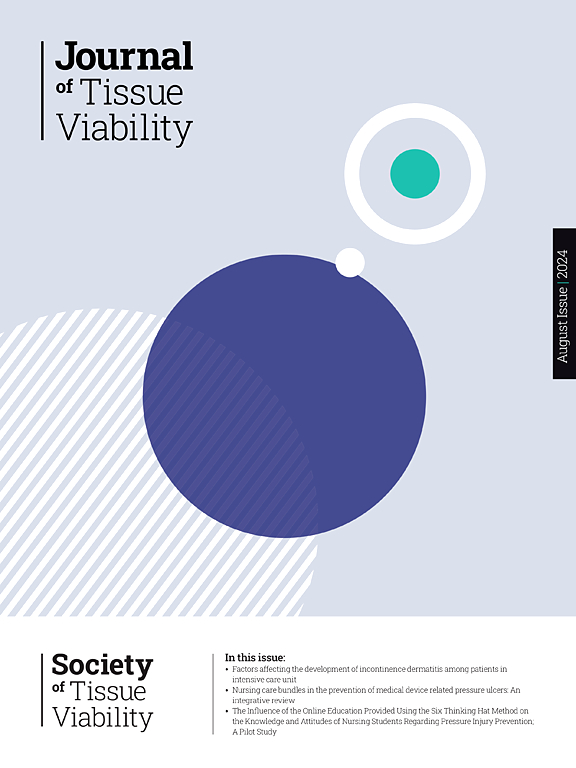用个性化定制的臀大肌肌皮瓣重建复杂肿瘤患者的广泛骶尾部缺损。
IF 2.4
3区 医学
Q2 DERMATOLOGY
引用次数: 0
摘要
目的:评估个性化定制臀大肌肌皮瓣(GMMF)重建复杂肿瘤患者广泛骶尾部软组织缺损的临床效果:对2021年12月至2023年8月期间因骶尾部大面积缺损而接受个性化定制臀大肌肌皮瓣重建术的8例患者进行回顾性病历审查。个性化定制的 GMMF 是根据组织缺损的位置、形状和不同死腔体积的变化而设计的。个性化 GMMF 的原则是确保皮瓣的旋转点能够到达缺损的最远端。对患者的人口统计学特征、手术特征和围手术期风险因素进行了分析。对临床结果进行了评估,重点是皮瓣坏死、伤口裂开、感染、血清肿和血肿等并发症:6名直肠癌患者和2名骶骨肿瘤患者接受了个性化定制的GMMF重建术,以治疗广泛的骶尾部缺损。创腔的平均容积为 104 毫升,平均垂直深度为 10.8 厘米。有六名患者的血清白蛋白偏低(结论:GMMF 是一种可用于骶尾部缺损的个性化定制方法:本研究中描述的个性化定制 GMMF 是重建复杂肿瘤患者深度较大的骶尾部伤口的有效方法。它允许肌肉瓣更大程度地旋转到骶尾部伤口缺损处,并通过利用肌肉组织的体积来消除死腔,从而提供充足的血液供应。本文章由计算机程序翻译,如有差异,请以英文原文为准。
Reconstruction for extensive sacrococcygeal defects in complex tumor patients with personalized customized gluteus maximus myocutaneous flaps
Aim
To evaluate the clinical effects of personalized customized gluteus maximus myocutaneous flaps (GMMF) for reconstruction of extensive sacrococcygeal soft tissue defects in complex tumor patients.
Methods
A retrospective chart review was conducted on 8 patients who underwent personalized customized GMMF reconstruction for large sacrococcygeal defect from December 2021 to August 2023. The personalized customized GMMF were designed based on the variations of tissue defect in location, shape and volume of different dead spaces. The principle of the personalized GMMF is to ensure that the rotation point of the flap can reach the farthest end of the defect. Patient demographics, operative characteristics, and perioperative risk factors were analyzed. Clinical outcomes were assessed, focusing on complications such as flap necrosis, wound dehiscence, infection, seroma, and hematoma.
Results
Six patients with rectal cancer and two with sacral tumors underwent personalized customized GMMF reconstruction for extensive sacrococcygeal defects. The average volume of the wound cavity was 104 mL, with a mean vertical depth was 10.8 cm. Six patients had low serum albumin (<35 g/L). After a mean follow-up of 15.5 months, no major complications occurred, except for one seroma that resolved within 2 weeks.
Conclusion
The personalized customized GMMF described in this study is an effective method for reconstructing large sacrococcygeal wounds with significant depth in complex tumor patients. It allows for greater rotation of the muscle flap into the sacrococcygeal wound defect and provides adequate blood supply by utilizing the bulk of muscle tissue to obliterate dead space.
求助全文
通过发布文献求助,成功后即可免费获取论文全文。
去求助
来源期刊

Journal of tissue viability
DERMATOLOGY-NURSING
CiteScore
3.80
自引率
16.00%
发文量
110
审稿时长
>12 weeks
期刊介绍:
The Journal of Tissue Viability is the official publication of the Tissue Viability Society and is a quarterly journal concerned with all aspects of the occurrence and treatment of wounds, ulcers and pressure sores including patient care, pain, nutrition, wound healing, research, prevention, mobility, social problems and management.
The Journal particularly encourages papers covering skin and skin wounds but will consider articles that discuss injury in any tissue. Articles that stress the multi-professional nature of tissue viability are especially welcome. We seek to encourage new authors as well as well-established contributors to the field - one aim of the journal is to enable all participants in tissue viability to share information with colleagues.
 求助内容:
求助内容: 应助结果提醒方式:
应助结果提醒方式:


